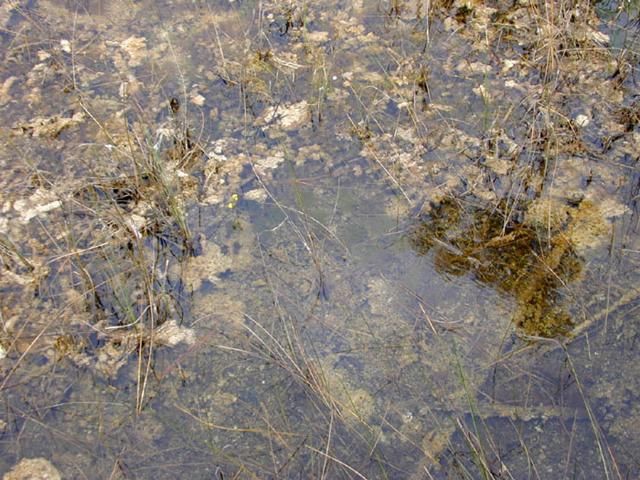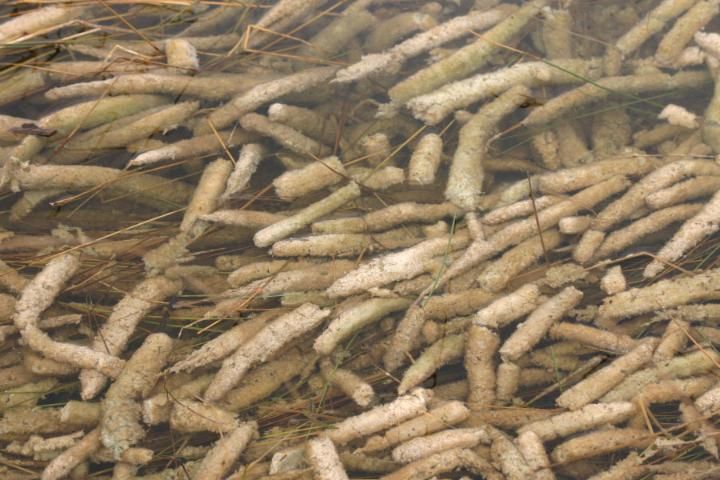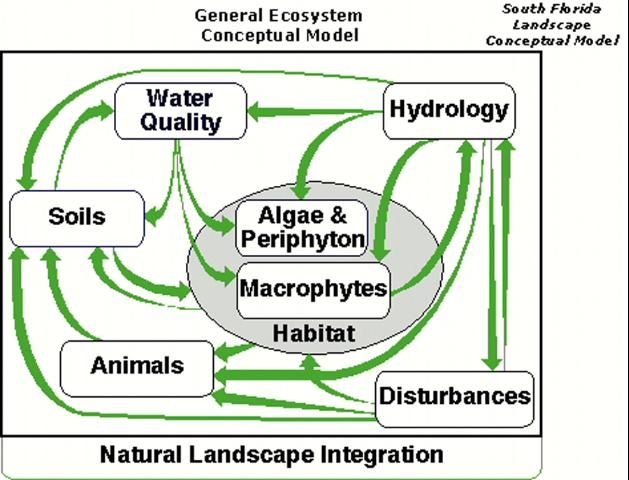Introduction
Historically, the Florida Everglades was composed of sizeable regions of sawgrass (Cladium jamaicense) marsh with wet prairies, sloughs, and tree islands, covering an area of approximately four million acres (Reddy and DeLaune 2008). However, its current size is approximately two million acres due to acreage loss from conversion to urbanization and agricultural use. A considerable amount of research, including the monitoring of water and soil quality and biological productivity has been conducted in the Everglades in the last several decades. An important component of this research focuses on the effects of anthropogenic (man-made) activities on habitat communities within the Everglades, including macroinvertebrates, macrophytes, and periphyton. The objectives of this publication are to: 1) define periphyton, 2) describe the role of periphyton in nutrient cycling for the Everglades ecosystem, and 3) explain the ongoing research related to periphyton in Everglades restoration. This document should be of interest to readers wanting to understand an important component of the Everglades ecosystem and an important focus of rehabilitation efforts.
Periphyton
According to the US Environmental Protection Agency (EPA), periphyton is a complex assemblage of algae, cyanobacteria, microinvertebrates, their secretions, and detritus attached to submerged surfaces (Figures 1 and 2). Most periphyton in the Everglades is considered calcareous due to abundance of the limestone (calcium carbonate) bedrock underlying the Everglades and from surface water inputs containing high cation concentrations. Periphyton is crucial and a fundamental part of the food web as the primary food source for small consumers, including fish and invertebrates (Gaiser 2008 and Lakewatch 2000). The South Florida Water Management District generated a model demonstrating the significance of periphyton for water quality and its interaction with other ecosystem components (Figure 3). Through physiochemical interactions with the surrounding environment and biota, periphyton affects many biological communities and ecosystem features including nutrient concentrations, soil quality, and dissolved gases (Gaiser 2008). For example, periphyton provides dissolved oxygen through photosynthesis to sustain much of the aquatic life in its surroundings (Lakewatch 2000). Furthermore, because periphyton responds rapidly to changes in the environment, it is an indicator of changing conditions (Gaiser 2008 and Lakewatch 2000).

Credit: From USGS South Florida Information Access (SOFIA) http://sofia.usgs.gov/.

Credit: Periphyton in the EvergladFrom USGS South Florida Information Access (SOFIA) http://sofia.usgs.gov/.

Credit: South Florida Water Management District, West Palm Beach, FL.
Role in Nutrient Cycling
Pathways for nutrient inputs into the Everglades include naturally occurring elements in soils, fertilizers as runoff from landscapes, and anthropogenic stormwater and wastewater disposal (Lakewatch 2000). Biological productivity is often limited by nitrogen (N) and phosphorus (P) availability. The majority of algae and aquatic plants, including periphyton, utilize N compounds for their growth and productivity (Mitsch and Gosselink 2000), although some periphyton can utilize N2 gas through a process called biological N2 fixation. Periphyton's ability to utilize P is limited by other factors including the forms of P, pH, water hardness, quantity of dissolved oxygen, and temperature. (Lakewatch 2000 and Mitsch and Gosselink 2000).
The Everglades Ecosystem
Periphyton communities, including various microalgae (with more than seven hundred taxa of algae), historically covered a large extent of the Everglades. Periphyton communities, along with sawgrass, are some of the most abundant communities in the Everglades and represent more than half of the primary production. As such, a goal of Everglades restoration projects is to reestablish calcareous periphyton in areas where it is absent.
Periphyton is most productive in areas where flooding occurs for more than six months of the year (Gaiser 2008), so extended water-level drawdown caused by drought or water withdrawals is harmful to productivity and reestablishment efforts. Environmental gradients affect the periphyton community's growth, structure, and extent of calcite encrustation. These gradients include changes in water chemistry, nutrient concentrations, and hydrologic conditions (Gaiser 2008 and Browder et al. 1994). Calcite encrustation levels of periphyton are also greatly affected by the water chemistry and CO2 concentrations because they control the diffusion of CO2 in water thereby controlling the saturation of CaCO3 in water. The water chemistry of the Everglades changes readily depending on the source of the water inflows. Water inflow varies from areas with only rainfall input to areas receiving primarily canal water inputs (Browder et al., 1994). Canal inputs often exhibit elevated nutrient concentrations, particularly P, which can initiate a shift in vegetative community composition away from periphyton toward cattail (Typha sp.). In these situations, cattails outcompete periphyton and sawgrass eventually leading to their displacement from nutrient-impacted areas. The primary mechanism is that dense growth of cattails shades the water surface to the point that sunlight penetration is too low to allow for periphyton.
High nutrient concentrations in the water column, including total P concentrations above 10 ppb, can cause dissolution and damage to periphyton (Gaiser 2008). Consequently, large-scale loss and shift in the periphyton community assemblage due to high P concentrations may negatively affect the invertebrate and fish communities that depend on periphyton as a food source.
Conversion of the Everglades into agricultural and urban land uses contributed to the wide-ranging decline of periphyton communities and their associated fish and macroinvertebrate communities. On the other hand, increased hydroperiod due to water management and hydrological restoration can encourage periphyton recovery and improved fish and invertebrate communities. In the long term, periphyton communities are expected to flourish with additional hydrological restoration in the Everglades (Gaiser 2008).
Ongoing Activities
Periphyton has been studied to a great extent in the Everglades because of its distinctive qualities and how it quickly responds to disturbance. These qualities allow scientists to use periphyton as an early warning indicator for impending changes to the environment. Another advantage is that periphyton communities are located throughout the Everglades, which allows scientists to monitor large areas for alterations and anthropogenic effects (Gaiser 2008). Scientists use this information to help manage water movement to ensure the health of the Everglades ecosystem.
The first periphyton-based stormwater treatment areas (STAs) was constructed in 2004 and utilized by 2007. This area covers 400 acres with an average water depth of two feet. The 400 acres was divided into cells and the soil removed down to the bedrock in order to prevent phosphorus flux from prior agricultural soils at the site. Water runoff first enters emergent vegetation cells, then moves into cells containing submerged aquatic vegetation (SAV). This is followed by cells containing SAV covered with periphyton and the final water treatment is accomplished by cyanobacteria-dominated periphyton mats.
Through research and monitoring, the periphyton communities in the Everglades are better understood today than decades ago. Research has provided details on periphyton composition, nutrient uptake, as well as nutrient thresholds, and has provided a better understanding of its role in nutrient cycling and the damaging effects of nutrient loading. Scientists are using this knowledge of periphyton for monitoring the restoration plans for the Everglades and also through use in the STA program.
References
Browder, J. A., P.J. Gleason, and D.R. Swift. Periphyton in the Everglades: Spatial variation, environmental correlates, and ecological implications. Everglades: The Ecosystem and its Restoration. West Palm Beach, FL: CRC Press. 1994.
Gaiser, E. Periphyton as an indicator of restoration in the Everglades. Ecological Indicators. Volume 9, Issue 6, Supplement 1. Amsterdam, Netherlands: Elsevier Publisher. 2008.
Mitsch, W. J., and J.G. Gosselink. Wetlands. 2000. John Wiley & Sons, New York.
Reddy, K. R., and R. Delaune. 2008. Biogeochemistry of Wetlands: Science and Applications. CRC Press. Boca Raton, Florida.